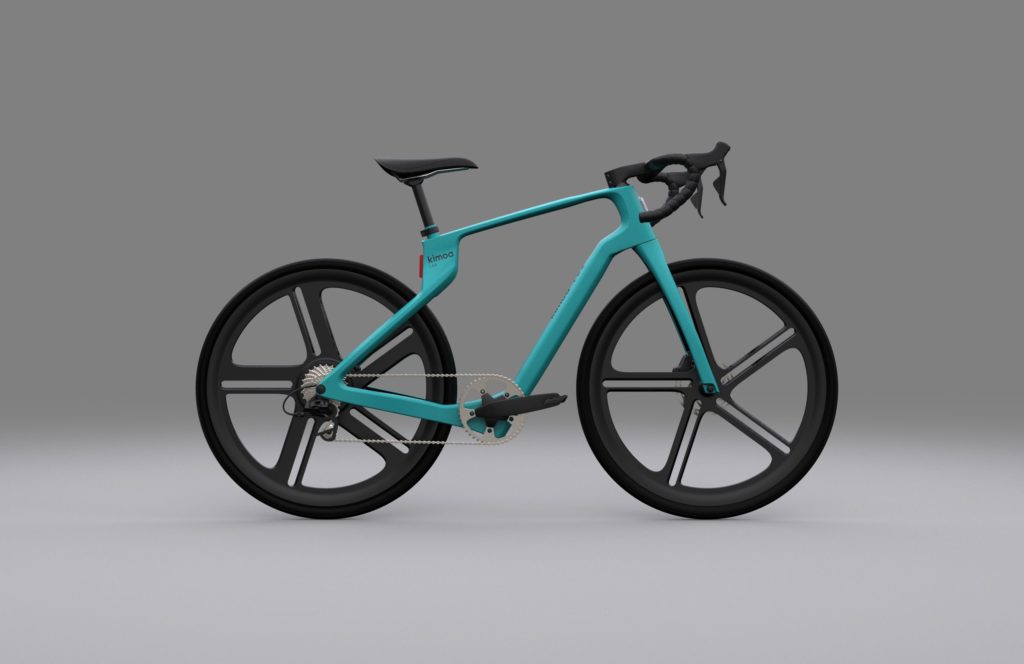Carbon fiber 3D printing firm Arevo continues to drive its presence in the cycling world, this time taking on two-time Formula 1 champion Fernando Alonso. Alonso’s lifestyle brand Kimoa has launched its first e-bike during the week of the FORMULA ONE CRYPTO.COM MIAMI GRAND PRIX 2022. And, thanks to Arevo’s technology, the bike is 3D printed to create a true unibody vehicle.
Like Arevo’s previous products, the Kimoa E-Bike is made-to-measure for every rider, 3D printed in a single pass of continuous carbon fiber thermoplastic composite. This means that customers can tailor the frame to match their heights, weights, arm and leg lengths, riding positions and even stiffness levels. In addition to riding styles (racing, street, gravel, or touring), cyclists can additionally choose between wheel material (metal or carbon fiber), and colorways (turquoise, fluorescent yellow, black, or white). Altogether, there are over half a million combinations possible with the Kimoa E-Bike.
Because the bikes are 3D printed in a single pass, they don’t suffer from the potential weakness found in joints of traditional carbon fiber bikes that are welded or glued together. This results in a stronger vehicle that is impact resistant, yet lightweight. The two-wheeler reaches a full charge in two hours, allowing for 55 miles of power. Footage of Arevo’s system 3D printing a bike frame similar to that of the Kimoa can be seen below.
“At the heart of Kimoa’s DNA is our drive to create a more sustainable lifestyle,” said Kimoa founder and global ambassador, Fernando Alonso. “The Kimoa E-Bike powered by Arevo gives people a curated step towards that active and sustainable lifestyle, tailored specifically for each rider.”
The Kimoa E-Bike was launched during race week in Miami at SimplyEV’s flagship store in Wynwood, where visitors can test out F1 car simulators and obtain an autograph with Alonso. It will retail starting at $3,999 at the Kimoa website online and at SimpleyEV and Simply Mac shops across the U.S. At any of these venues, the bike can be customized before shipping just several days later.
$3,999 actually isn’t a bad price for a higher end e-bike. Entry level models typically range from $700 to the low thousands. More costly e-bikes approach $3,000. For a custom, 3D printed electric two-wheeler, $3,999 is only a small premium for someone who’s already purchasing a luxury item.

A rendering of the Kimoa E-Bike. Image courtesy of Arevo.
With e-bikes, Arevo has found a niche that takes advantage of its continuous carbon fiber 3D printing technology, capable of producing large objects, without an excessive cost. It’s a very interesting route for the startup to take, as other continuous carbon fiber businesses tackle smaller items. This has enabled Arevo to find commercial applications quickly, while other large-format carbon fiber 3D printing firms like Continuous Composites and Impossible Objects take other paths.
At the same time, I can’t help but wonder what Arevo is up to with its collaboration with In-Q-Tel. I imagine that its public operations must complement its work with the intelligence community’s investment firm in some way. What parallels e-bikes might have with military technologies is difficult to determine, but we can picture objects of similar sizes and requirements being produced with Arevo technology: small drones, quadruped robots, or even exoskeletons are all possibilities.
Meanwhile, Arevo’s involvement in the production of bikes, e-bikes, and other electric vehicles allows it to continue developing its own 3D printing technology. It can then sell these to the market in the form of its Aqua series of 3D printers, which will further expand its operations globally, from Japan to France. It’s enough to make you think Arevo could be our next unicorn, or a Soonicorn, as 3DPrint.com’s Vanesa Listek calls them.
Subscribe to Our Email Newsletter
Stay up-to-date on all the latest news from the 3D printing industry and receive information and offers from third party vendors.
You May Also Like
3D Printing News Briefs, April 13, 2024: Robotics, Orthotics, & Hypersonics
In 3D Printing News Briefs today, we’re focusing first on robotics, as Carnegie Mellon University’s new Robotics Innovation Center will house several community outreach programs, and Ugogo3D is now working...
Rail Giant Alstom Saves $15M with 3D Printing Automation Software 3D Spark
3D Spark has entered into a three-year deal with the rail giant Alstom. Alstom, a transport behemoth with annual revenues of $16 billion, specializes in the manufacture of trains, trams,...
Meltio Expands Global Reach with New Partnerships in the Americas and Europe
Spanish 3D printing manufacturer Meltio has expanded its sales network across the globe. With the addition of three new partners in the United States, Brazil, Argentina, and Italy, Meltio aims...
3D Printing Webinar and Event Roundup: April 7, 2024
Webinars and events in the 3D printing industry are picking back up this week! Sea-Air-Space is coming to Maryland, and SAE International is sponsoring a 3D Systems webinar about 3D...































